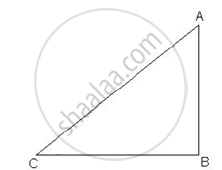Advertisements
Advertisements
प्रश्न
In the below given figure, a tower AB is 20 m high and BC, its shadow on the ground, is 20√3 m long. Find the sun’s altitude.

उत्तर
LetAB be the tower and BC be its shadow.
AB = 20, BC = 20√3
In ΔABC,
`tan theta= `
`tan theta=20/(20sqrt3)`
`tan theta=1/sqrt3`
`but,tan30=1/sqrt3`
`theta=30^@`
The Sun is at an altitude of 30º .
APPEARS IN
संबंधित प्रश्न
Evaluate without using trigonometric tables,
`sin^2 28^@ + sin^2 62^@ + tan^2 38^@ - cot^2 52^@ + 1/4 sec^2 30^@`
Without using trigonometrical tables, evaluate:
`cosec^2 57^circ - tan^2 33^circ + cos 44^circ cosec 46^circ - sqrt(2) cos 45^circ - tan^2 60^circ`
Without using trigonometric tables, evaluate
`sin^2 34^@ + sin^2 56^@ + 2tan 18^@ tan 72^@ - cot^2 30^@`
Prove the following identities, where the angles involved are acute angles for which the expressions are defined:
(cosec A - sin A) (sec A - cos A) = `1/(tanA+cotA)`
[Hint: Simplify LHS and RHS separately.]
Without using trigonometric tables, evaluate :
`sin 16^circ/cos 74^circ`
Without using trigonometric tables, evaluate :
`sec 11^circ/("cosec" 79^circ)`
Without using trigonometric tables, prove that:
cosec272° − tan218° = 1
Without using trigonometric tables, prove that:
sin35° sin55° − cos35° cos55° = 0
Without using trigonometric tables, prove that:
(sin72° + cos18°)(sin72° − cos18°) = 0
Without using trigonometric tables, prove that:
tan48° tan23° tan42° tan67° = 1
Prove that:
`(2 "sin" 68^circ)/(cos 10^circ )- (2 cot 15^circ)/(5 tan 75^circ) = ((3 tan 45^circ t an 20^circ tan 40^circ tan 50^circ tan 70^circ)) /5= 1`
Prove that:
\[\frac{\sin\theta \cos(90^\circ - \theta)\cos\theta}{\sin(90^\circ- \theta)} + \frac{\cos\theta \sin(90^\circ - \theta)\sin\theta}{\cos(90^\circ - \theta)}\]
Prove that:
\[\frac{sin\theta \cos(90° - \theta)cos\theta}{\sin(90° - \theta)} + \frac{cos\theta \sin(90° - \theta)sin\theta}{\cos(90° - \theta)}\]
If tan 2 A = cot (A − 12°), where 2 A is an acute angle, find the value of A.
Given that `tan (θ_1 + θ_2) = (tan θ_1 + tan θ_2)/(1 - tan θ_1 tan θ_2)` Find (θ1 + θ2) when tan θ1 = `1/2 and tan θ_2 = 1/3`.
From the trigonometric table, write the values of tan 45°48'.
Solve the following equation: `(cos θ)/(1 - sin θ) + cos θ/(1 + sinθ) = 4`.
Prove that:
`(sin^3 theta + cos^3 theta)/(sin theta + cos theta) = 1 - sin theta cos theta`
